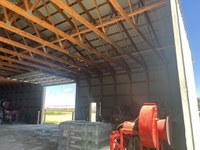Building owners should determine full extent of storm damage
(Click the image below to view a high-resolution image that can be downloaded)
Storm damage to structures is obvious in many cases, but what you don’t notice immediately also may weaken the building or cause other problems. Wind can create extreme forces that will lift or push a whole building or parts of the building. Often, the damage is hidden within the structure and not immediately obvious.
Building owners should do a close inspection of the structure from the outside to check for damage, advises Ken Hellevang, North Dakota State University Extension agricultural engineer and professor emeritus. He recommends checking if the ridge and eaves are straight, the walls are vertical and straight, and the building has not shifted on its foundation.
Owners also should look for indications that frame members, such as knee braces, have been pushed into the siding or up into the roof. Check for missing or damaged shingles, loose nails (if metal roofing) and any signs of leaks. Examine for cracks, particularly near corners, under windows and doors and around the foundation.
“If the building has been moved, shifted or twisted, it may not be safe to enter,” says Hellevang.
Other damage becomes evident inside the building. Examine the trusses and rafters for signs of crushed, split or broken wood. Determine whether any members have buckled, twisted, bowed out of alignment, slipped relative to each other or developed gaps between members in a truss joint. Also, examine whether the gussets show signs of being deformed. Look carefully at connections for indications of nail, screw or bolt holes being elongated, and see whether nails or other connectors are pulled out of the wood or bent.
- Ceilings: Look for sagging, cracks, water stains or signs of bulging.
- Walls: Check for cracks, especially in corners, and look for any signs of bulging or soft spots.
- Floors: Inspect for sagging, sloping or cracks.
Hellevang says an inspection for structural damage also should include the following:
- Examine the posts of pole buildings for crushed or broken wood near the ground or at truss connections or knee braces. Make sure the posts are straight and vertical. Look for indications that posts made of more than one board may have split along rows of nails.
- Check whether doors or windows open as they did before the storm. If they don’t, this may indicate the structure has shifted. In case of severe shifting, water lines, gas lines and electrical circuits may have been damaged.
- If wetness occurred because of flooding or leaking roofs, look for wet electrical circuits, wet insulation and other water damage to the structure’s interior. Once insulation in a wall or attic becomes wet, it must be replaced or the wall must be opened. Wall insulation that is sealed within the structure will not dry.
- Look at the siding and roof sheeting for tears around fasteners, evidence of fasteners being pulled, and bends or buckles in the sheeting. See whether the sheets are still aligned with each other.
This building inspection is also a good time to check the wood for indications of rotting or other damage that could weaken the building, according to Hellevang. Document the damage with pictures and contact your insurance company.
"Buildings that show signs of damage will need to be repaired," says Hellevang. "Truss members may need to be replaced or additional boards placed from joint to joint. Additional and larger gussets may be required for damaged joints. Additional nails or screws may be required. Nails and screws should not be placed too close to each other or they may weaken the wood.”
However, the cost of repairs may exceed the value of the building in some cases, he notes.
He suggests that building owners consult a building contractor or engineer if they see several indications of damage.
"The value of machinery, vehicles and equipment stored in a building can be several hundred thousand dollars," says Hellevang. "It doesn't make sense to put that value or yourself at risk with a building that is structurally damaged.”
NDSU Agriculture Communication – June 23, 2025
Source: Kenneth Hellevang, 701-231-7261, kenneth.hellevang@ndsu.edu
Editor: Dominic Erickson, 701-231-5546, dominic.erickson@ndsu.edu


